Another border crossing, this time between Tanzania and Zambia. For the first time our vaccination booklet is checked, by a young woman with the name of Happy. She is mainly interested in the vaccine against yellow fever. At the emigration desk, where a hen is incubating her eggs behind a cupboard, it goes very quickly too. About 1 km further on we arrive at the Zambian customs. We are received by a young man who fills in a document and informs us that everything is OK. We ask him to fill in and seal the customs booklets. Only the chief can stamp the customs documents but he is not there. He will try to contact him, it is true that it is Saturday. He informs us that he will be there in 45 minutes. We wait for a good hour and take advantage of it to have a restorative nap under the sun.
The chief arrives, a chubby, friendly older guy. He apologises for his lateness, it’s no problem now that we’re well into Africa mode. He dutifully fills out the log books and we have to pay a carbon tax of 6,00 € per bike. We’re about to leave when we’re accosted by the immigration officer: “Have you got your passports filled in, can I see them? “Do you want to get arrested and end up in jail?” Oops we skipped emigration, $25.00 for the visa per person a stamp on the passport and that’s it.
We stop about fifteen kilometres after the border in a campite which borders the lake chila. As we stay two days, we take the opportunity to wash our clothes. Yes, doing our laundry ourselves by hand is really for emergencies, when we have used all four sides of our underwear 😉
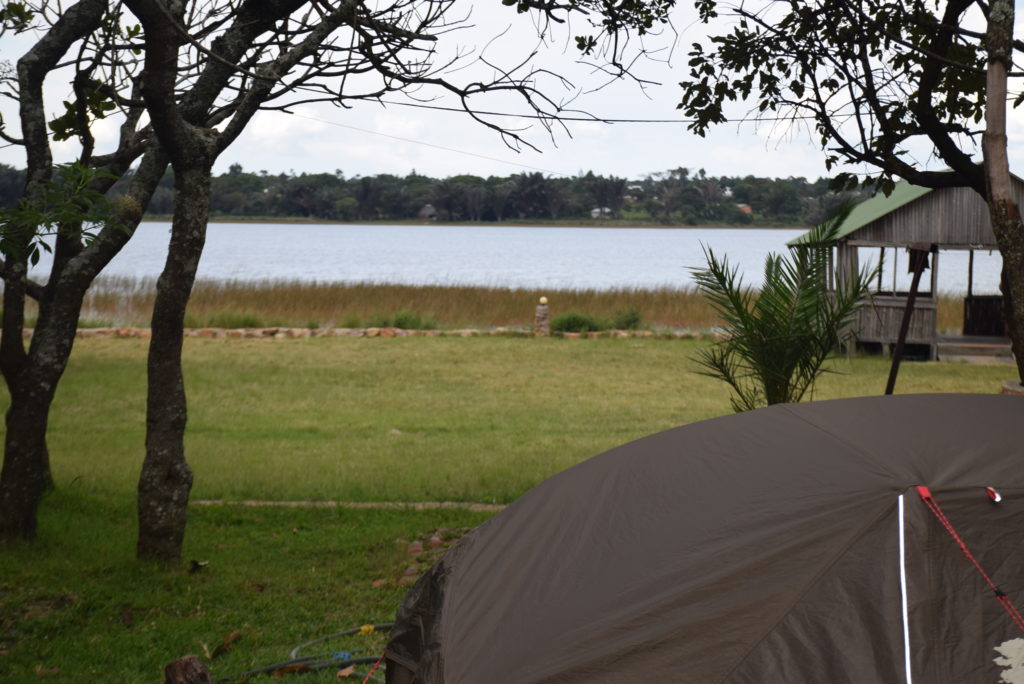
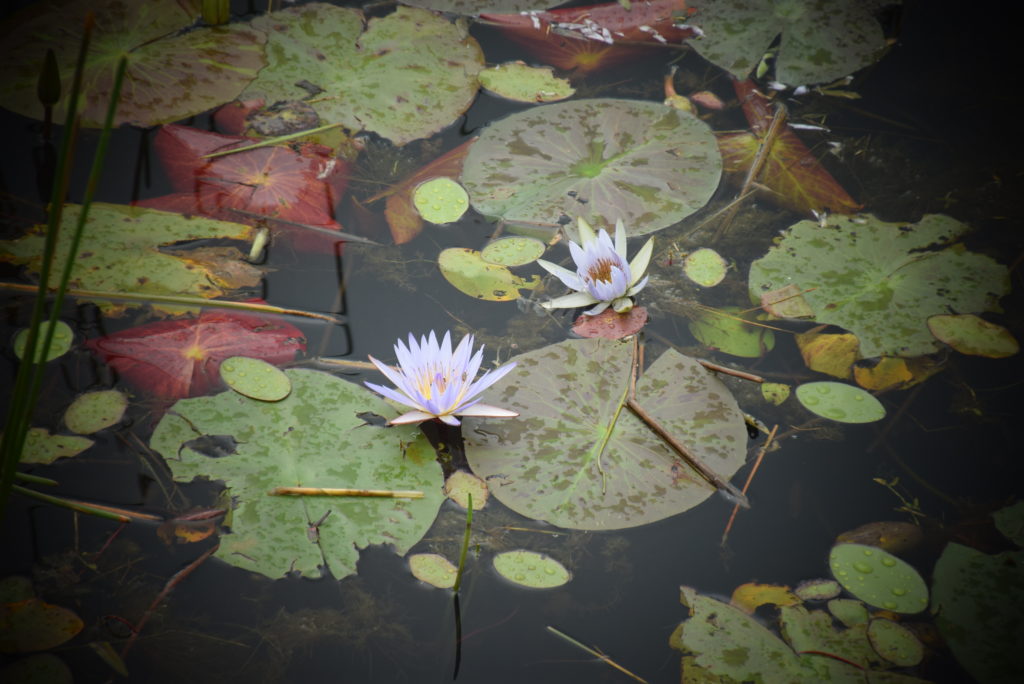
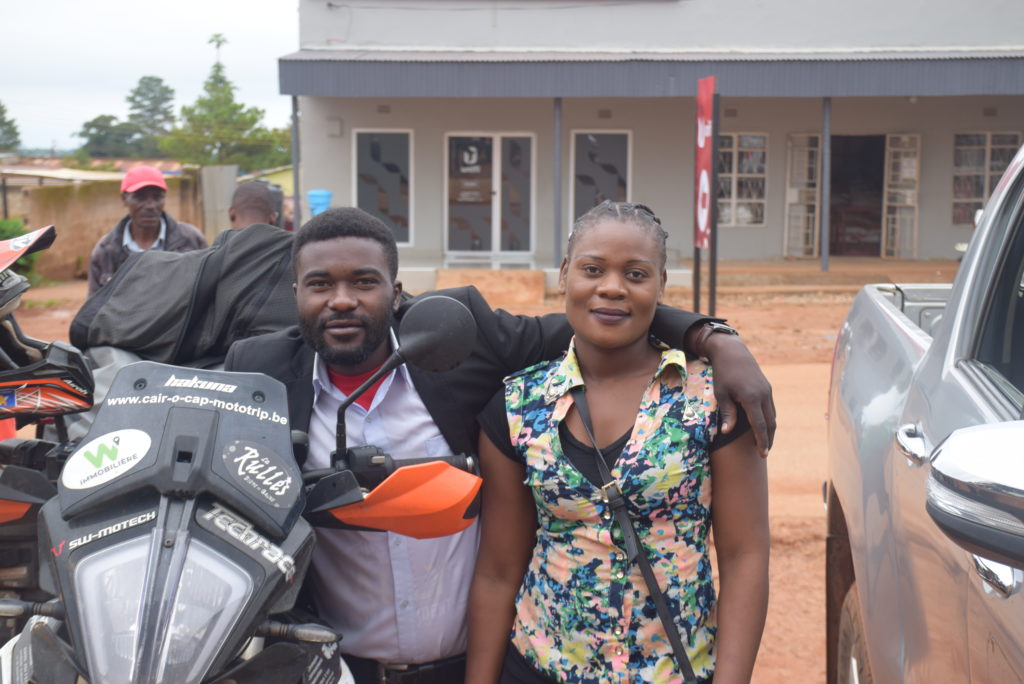
In the late afternoon we hear music coming from the edge of the lake a few hundred metres from the camp. From the sound of the instruments we can tell that it is a concert. After the dinner we decide to go to the place. It is a trendy bistro where local bands play. The owner gives us a warm welcome and provides us with two chairs. We spend a good evening on African rhythms discussing with two young people of the region, who came to us by seeing on our clothes, our logo with the African continent.
Next day
It keeps raining and it’s cold. We got used to the heat, now when the mercury drops below 20 degrees we feel cold. We spend most of the day in our tent. I take the opportunity to write down everything that comes to mind while François prepares the itinerary for the next few days
Day after
We get ready to leave, we fold the tents which are soaked. Our laundry is obviously not dry as it rained all day yesterday and all night. We have to pack it in a plastic bin bag.
After about 170 km of driving we reach our destination under a bright sun, the Chishimba Falls. Wow, what a beautiful place. We start by tying up all our straps and tie them between two trees to quickly dry our clothes. We unfold our tents to dry them as well.
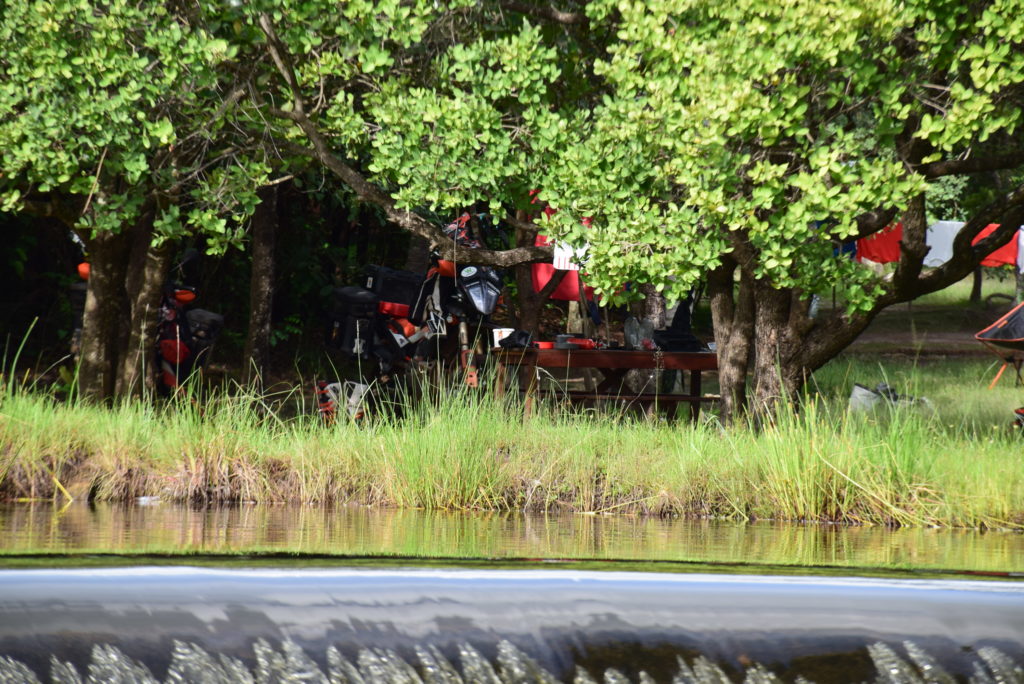
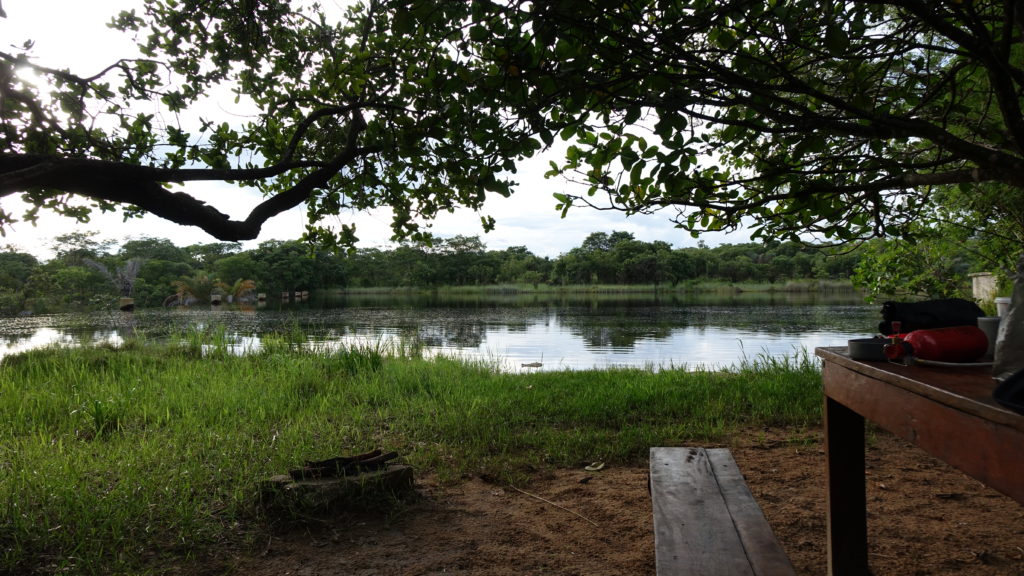
We spend a nice late afternoon and evening. The night will be rainy: waterspouts fall under a violent storm. I wake up at the beginning of the night, pressing my hand on the tent’s floor, I feel like I’m on a water mattress. I throw all my stuff in my bag and put on my rain gear thinking that the lake is overflowing and that I will have to move my tent. I put my headlamp on my forehead and get out of the tent, it’s raining. I shout at François twice, nothing happens. I walk around the tents and see that there are torrents of water on both sides of the tents, and also between the tents. There is some water under the tent but it is not worrying. I tell myself that we are really lucky that the tents are placed right between these torrents. Only my bike is in one of these streams. I fear that the stand will sink and that it will end up falling. I decide to move it, I start it and I go between the two tents to park it in a safer area. Still no reaction from François, I think the train could pass through his tent without him noticing. I go back to my tent to make sure everything is ok. I don’t need to tell you the details of how to get into a tent with dripping rain clothes and completely rinsed walking shoes without getting it everywhere.
The next morning when we wake up, it is not raining anymore but everything is soaked. We take advantage of this lull to go and see the three waterfalls of the site. They are magnificent, what a spectacle. On the way back we had lunch and went shopping in the nearest town 36 km away. On the way back, three kilometres before arriving, a new stormy shower rinsed us to the underwear.
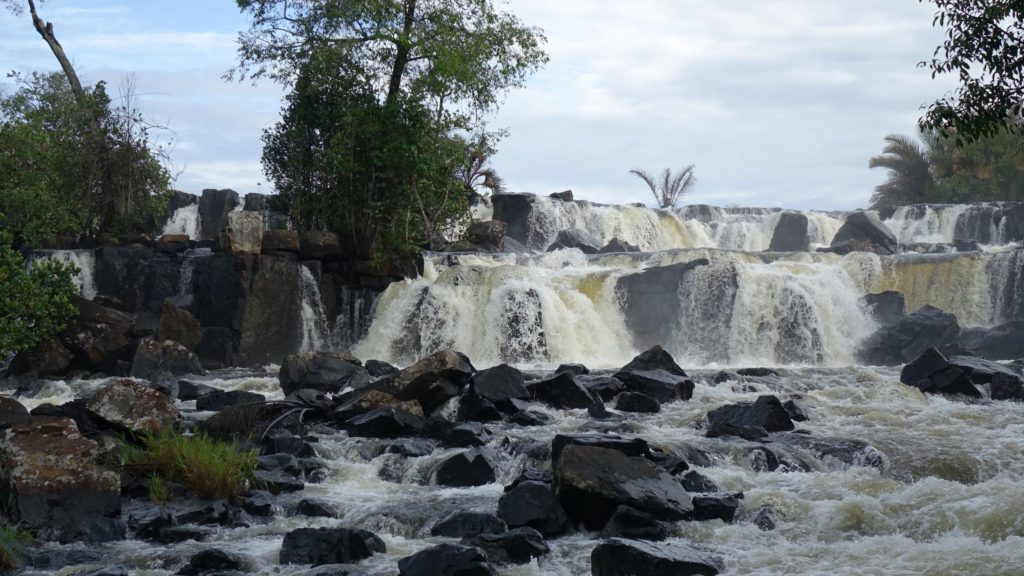
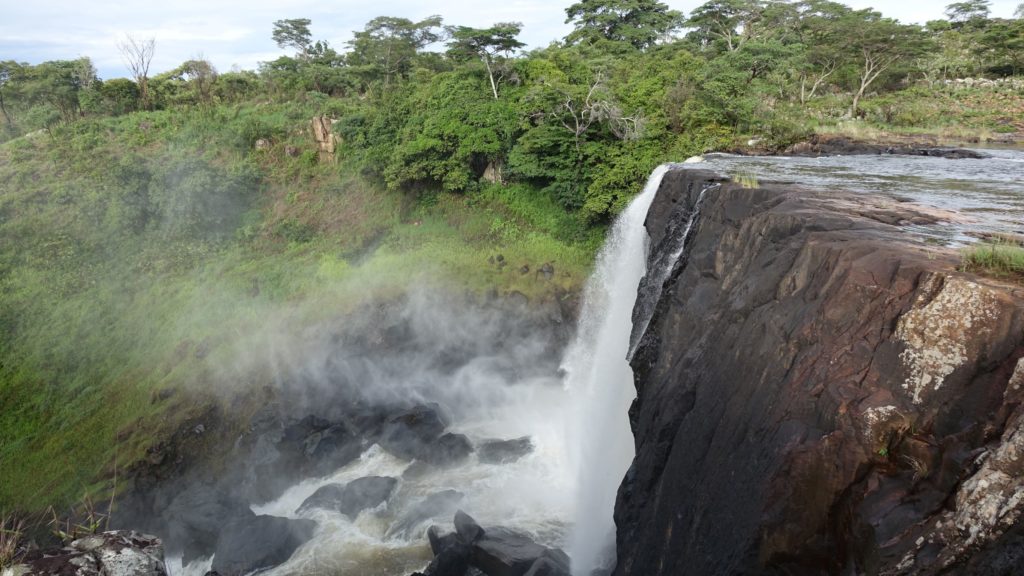
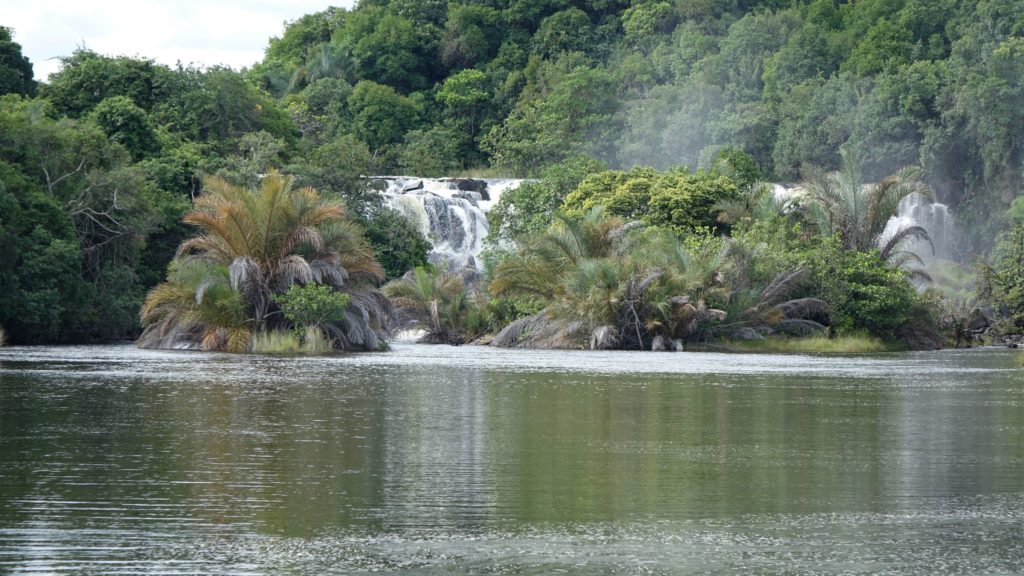
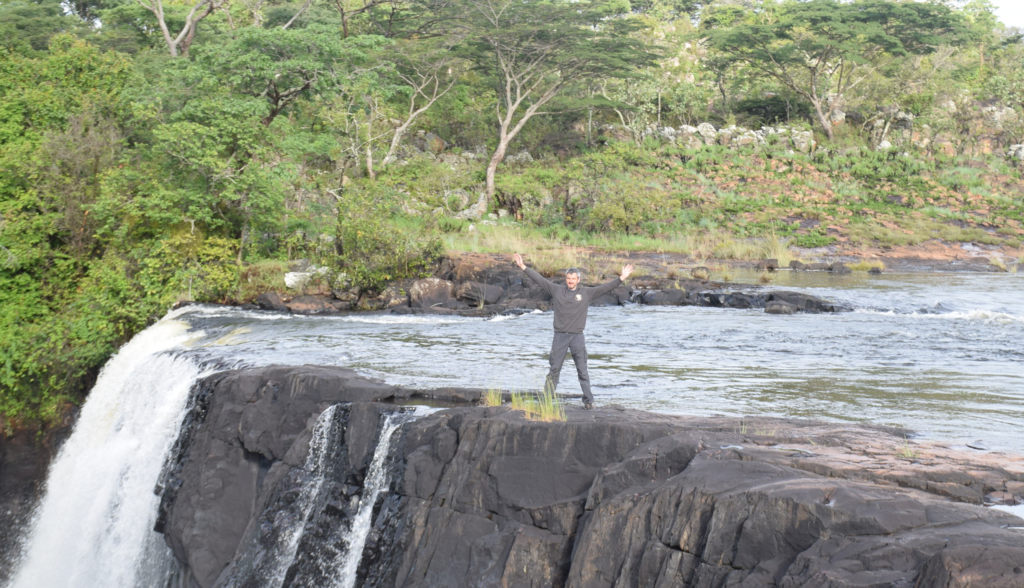
The next morning after another rainy night, I wake up and take a picture of the lake from inside my tent. I put my camera in its bag, I turn around again towards the lake, and there I see a wave of water approaching at high speed towards the edge of the lake, right in my direction. I think to myself what the hell is that animal coming, it could be a crocodile, the receptionist has confirmed that there is none. Suddenly a head followed by a long blow quickly comes out of the water, it happens 6 meters away from me, for a split second I think I see a snake coming out of the water. I’m out of the tent in a flash; behind the head and the long blow a body comes out of the water with four legs and a tail, an otter. Pffff what a scare it gave me. For those who have already seen Jurassik Park, the head of the fat man with glasses sitting on the toilet when the dinosaur is about to eat him, well I had to have the same one. Just to clarify: I have a phobia of snakes. So what the hell am I doing in Africa? I’m treating myself, but it’s not very effective. Let’s get back to the otter, when she saw me coming out of the tent like the marsupilami she got scared and went back to the water. Of course I tell this episode to François who was at that moment at the shower, well at the sink, no shower in this camp, it makes him laugh.
200 km further on, after 35 km of winding track and many changes of pace we arrive at the Hot Spring campside. Mark the owner welcomes us, he is in his sixties and is English. He was born in Kenya and has always lived on the African continent. He is small and a bit austere. He advises us to place our tents under a canopy as it is the rainy season. He was well advised, as soon as we set up our tents we are hit by another storm with heavy rain.
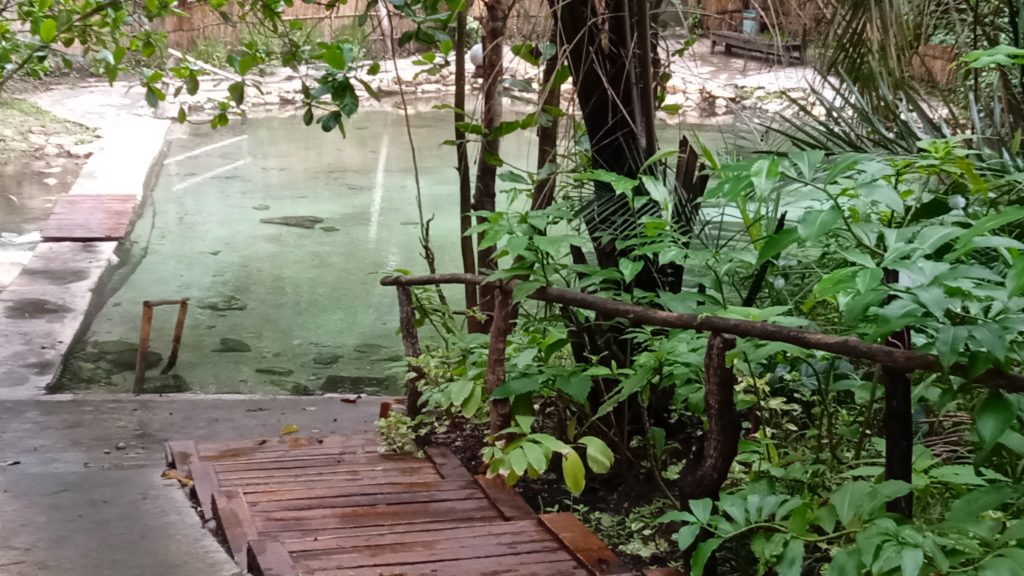
The bar and restaurant are spacious, decorated in an overloaded kitsch style. The walls are filled with everything from family pictures of each dog, to pictures of the local wildlife, to signs like: “Dogs are welcome, humans are tolerated”; “If you can read this sign, you still need a beer”; and multiple objects from African culture: weapons, tools, pirogues, etc. You add to this junk the boss who crosses this room in his superman coloured bathrobe, a soap in one hand, a radio in the other, on his way to his daily bath at the hot spring, and you have the whole picture.
The camp is full of green vegetation, and includes this famous hot spring in which we will relax. At the end of the day we go to the bar for a drink and get to know the barmaid. She has travelled a lot in Europe and is planning to return. We will talk about the trip, the countries visited and the next ones planned.
Next day
About 30 km of track and we find a main road again. As on the previous days, all along the road, sometimes hidden in the vegetation, sometimes located on a partially deforested area, there are houses. Some of them, more rare, have windows and windows, the majority look more like huts whose vegetal walls have been replaced by bricks. Many people stand by the roadside selling a few tomatoes, mangoes, mushrooms, bags of charcoal made by cutting down trees in the vicinity, live poultry, etc. Again, poverty is there before our eyes. And yet many thumbs up and smiles accompany our passage.
The carriage is mainly composed of semi-trailers. The headlights, the horn or the arm outstretched and the thumb out of the cab are frequent. In some places, the road disappears completely to make way for a field of laterite holes, each bigger than the next. Add to this the regular rains and you have a happy quagmire. It is easy for us to find a soft path between these holes. However, the trucks are forced to pass through some of them. It feels like the cab is going to come off the truck. The torsion undergone by the axles is impressive.
We find a narrow track for about 30 km. This one is essentially made of sand. François has a lot of fun on this track, as for me it’s a bit of hell, we have to keep the speed up so that the bike keeps its stability. This does not prevent the front wheel from drifting. I went off the track twice without any consequences.
The place is incredible ” Mutinondo ” We are in the middle of the bush in a place developed since 1995 by a couple of enthusiasts. Private site of 77 hectares if I remember correctly. Lodge and campsite, with multiple hikes and viewpoints. The landscape is very green with round granite mounds surrounded by forests, and a waterfall. There is a restaurant area open to nature and a bar with a view over the forest where we will have an aperitif while admiring the view. There is a soothing calm. We decided to stay for two days because we were so charmed by the place.
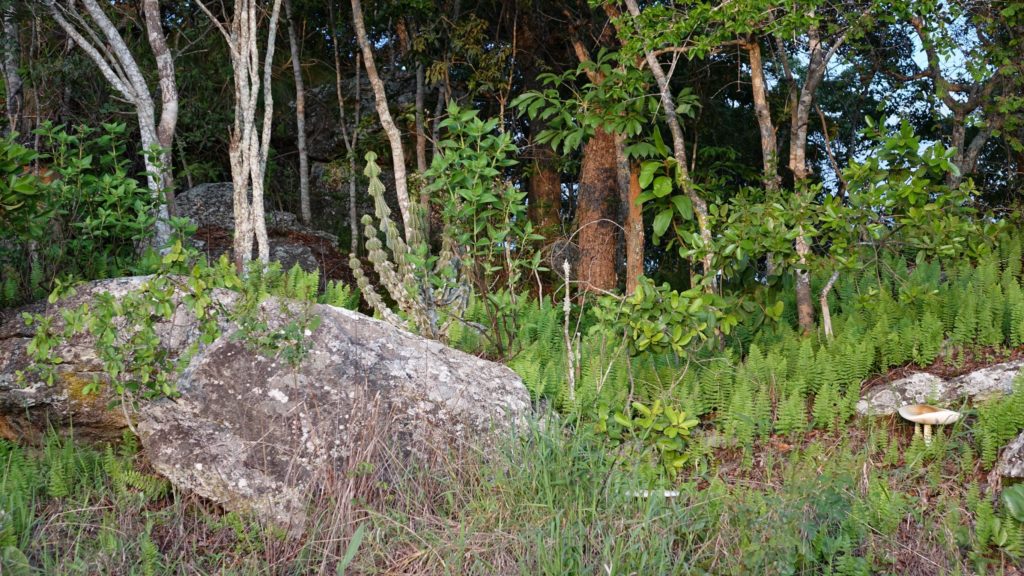
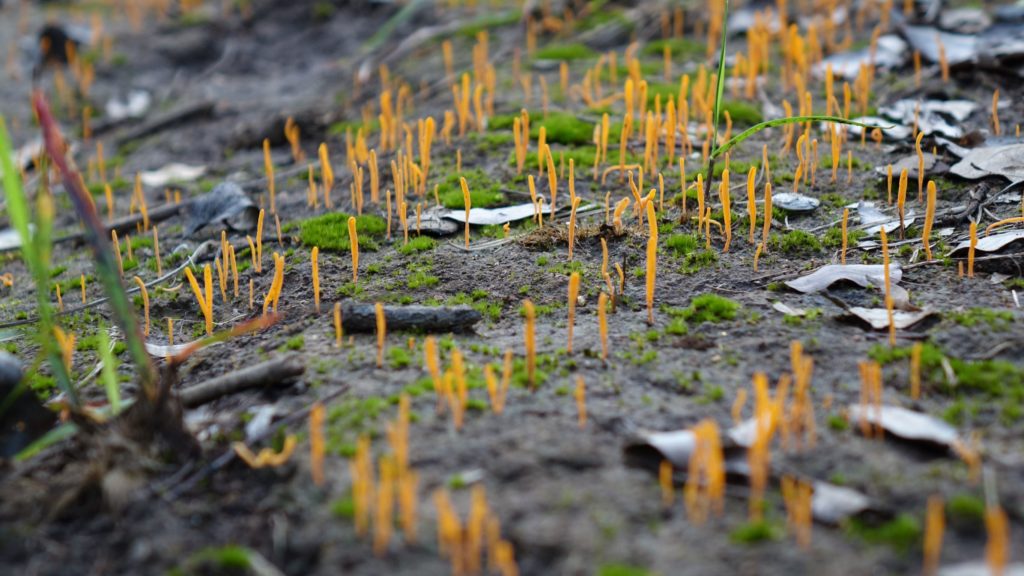
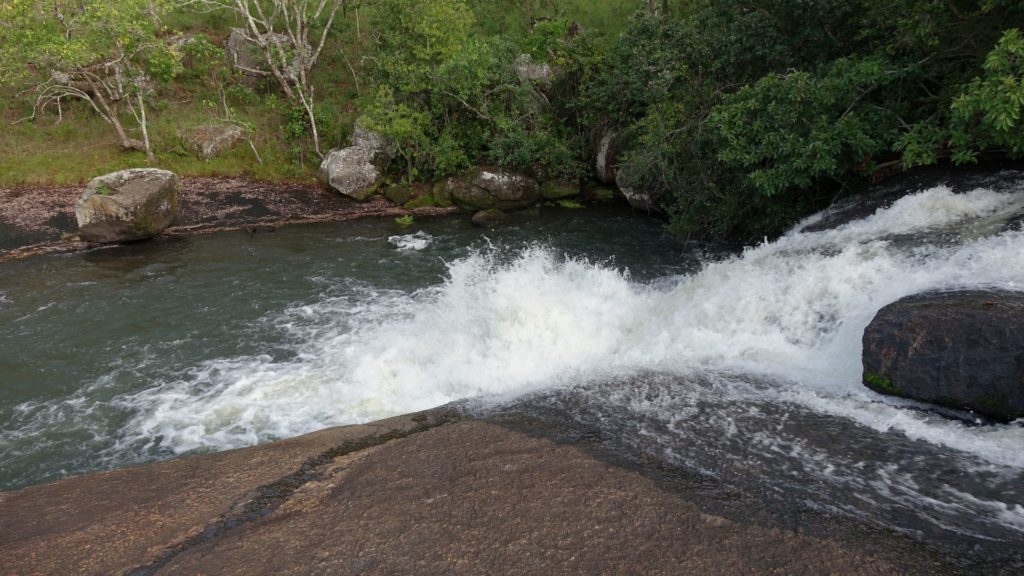

We take the opportunity to go for a walk on the estate. We climb one of the mountains from which we have an extraordinary view of the forest. During this hike I can’t help but think about snakes; inevitably when you see an emergency number for snake bites in each camp. So much so that at every suspicious noise I startle. It’s amazing how much stress our brains can put us in when there’s not a snake in sight.
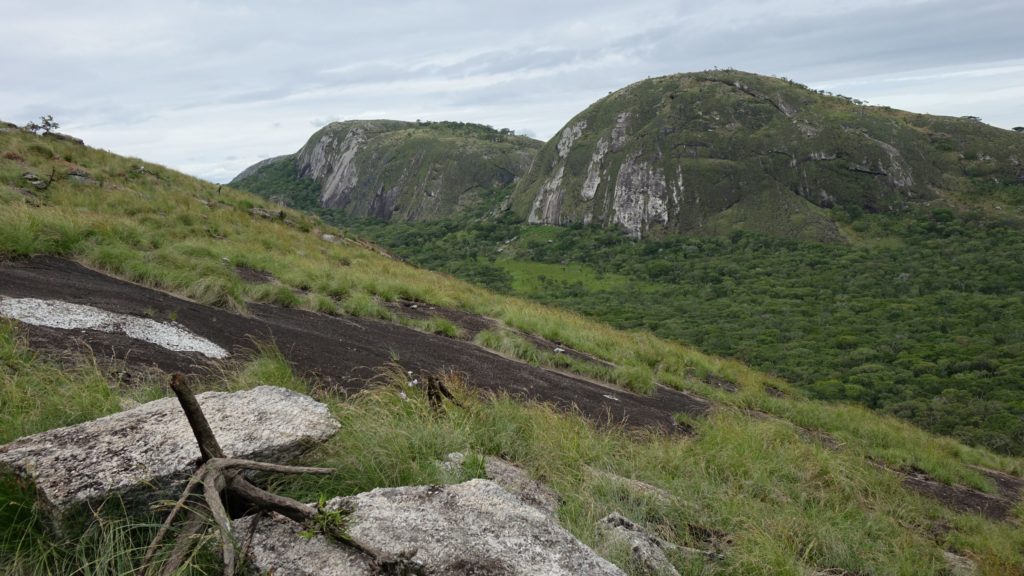
We will have the chance to share our breakfast with the owners of this estate who have created this whole space over the last 25 years. Today, they have reached a respectable age and they want to hand over their estate. They are well aware that the good times are over, that this business was better 5 or 10 years ago. We wish them the best of luck in finding a buyer and enjoying a well-deserved retirement.
The next morning we leave this paradise, after our daily tetris session, which is now well established, we go to the reception to pay the bill. And there I get bitten by one of the two dogs. Fortunately my motorbike trousers protected me well, but it’s still very unpleasant. This dog has two wires that touch each other, he is aggressive with everyone for no reason, he had already grabbed my trousers the day before. This shows that the danger is not necessarily where you imagine it.
Here we are on this sandy track. After only three or four kilometres I lose control of the bike, the front end slides back and forth, the rear end slides back and forth and I can’t hold the bike back as it sinks into the sand. I’m sorry I let myself get trapped again. François has gone ahead and I am alone to get the thing up. The bike is lying on its left side. I turn my back to him, I take the handlebars in my right hand and the rear handle in my left, I bend my legs, pulling my head back to avoid forcing my back and I push with all my strength with my thighs. My feet sink and slide into the sand, the bike doesn’t move. It’s not easy. I decide to clear some sand under the wheels to straighten it a bit. It will be more difficult to start again but it doesn’t matter. I make two trenches in the sand where I’ll put my feet and I try to pack the sand as much as possible. I get back into position and push like an ox on my legs. The bike starts to get up, damn it’s heavy. I finally manage to get it upright. I have my back to the bike, I don’t want to let it fall, I move my hands and finally grab the handlebars. Ok, I sit on it, I start again. 40 meters further, I put the bike down again. This time it is perpendicular to the track. Everything has to be done again. I start to raise it with the same technique, I’m almost there, but I’m out of breath and out of strength, if I let go I won’t be able to raise it again. I give it all I’ve got and manage to get her up. I take the stand out thinking I can breathe a little, as the bike is across the track the stand is more than 10 centimetres from the ground. I’ll have to move it by staying next to it. I start the engine and by small games of “I advance and I move back” by turning the handlebar I manage to position it in the good direction. I get back on it. I have about 25 kilometres of sandy track left and my confidence is completely shattered. I have no choice but to continue. It takes a lot of mental effort to continue in these conditions. In the end I would get away with three additional run-offs with no consequences.
In the evening a new track with sandbanks, in view of my experience of the morning, I concentrate to the maximum not to tense on the handlebars and to be reactive on my supports. It goes relatively better.
We arrive at the David Livingstone Memorial. Where he died in 1873. We thought we were going to a tourist spot. However, the track is so impassable for four-wheelers that there is no one there. We will be alone to pitch our tents, except for the presence of the night guard. Without any source of light pollution, we will enjoy an extraordinary starry sky as it is no longer possible to observe in Belgium.
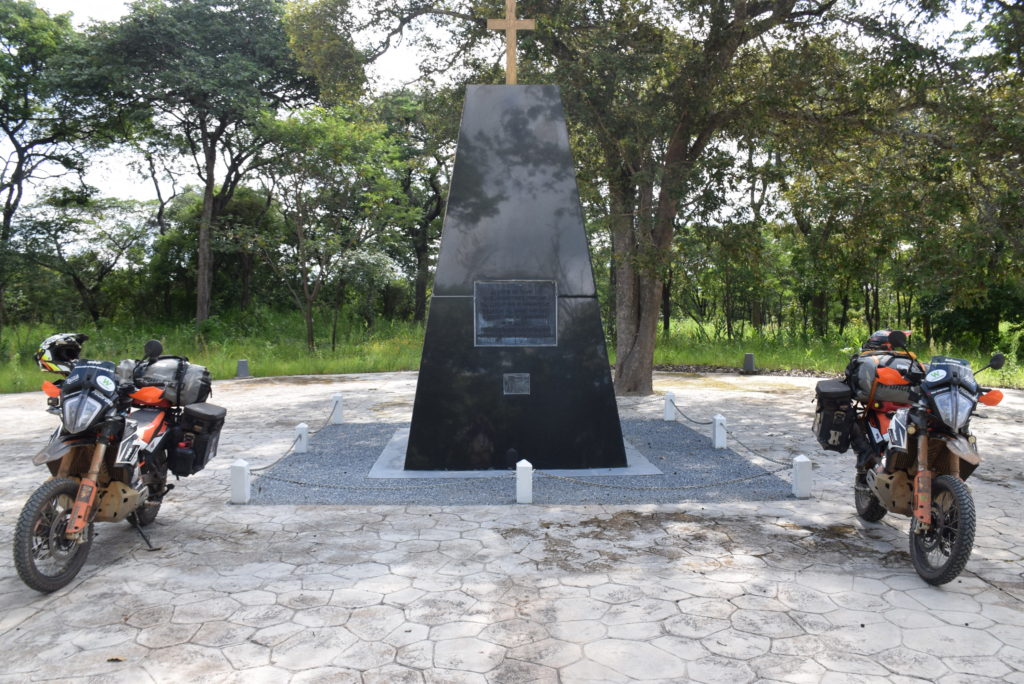
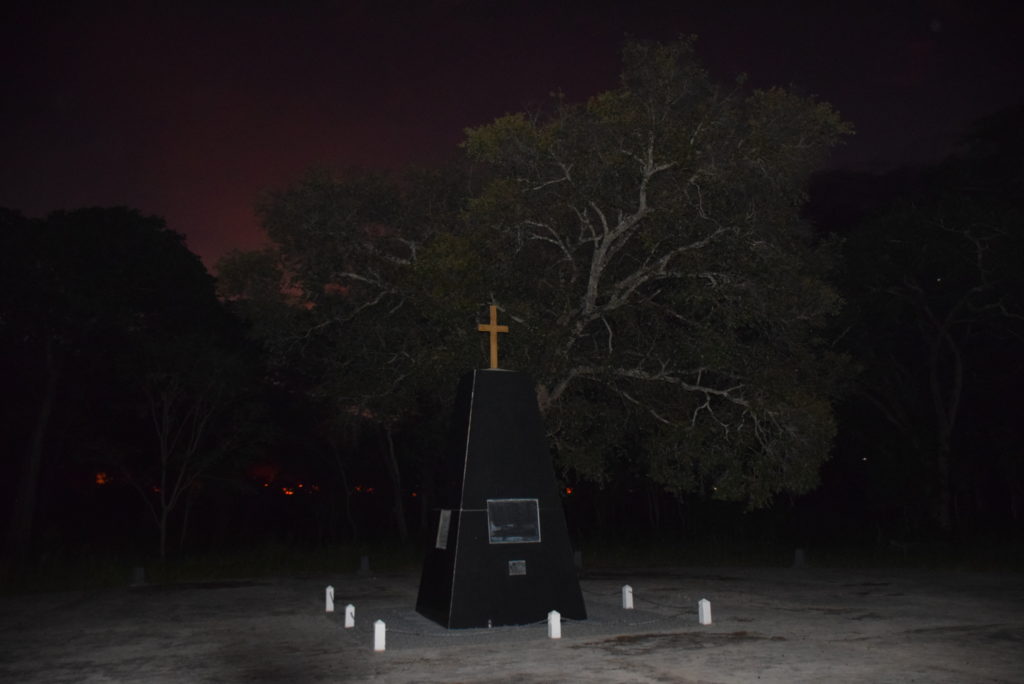
The next morning we visited the building that recalls the life, expeditions and discoveries of David Livingstone. We pale in comparison to what this extraordinary man accomplished, at the cost of his health and his life. David was deeply affected by the slavery of the African people. He worked tirelessly to help abolish the deportation of slaves. In the year of his death, thanks to his commitment, the deportation of slaves from the coastal areas of Africa and also from the interior was abolished. I didn’t really know Livingstone’s story, it’s a nice encounter even if it is post mortem. I think this man’s memory should continue to be honoured and his story told in the same way as a Nelson Mandela, closer to our time.
In the afternoon we arrive at a campsite. A beautiful place in the nature with an outdoor kitchen, a private bathroom and an outdoor shower.
The next morning, while watching me loading my luggage, François noticed that my luggage had a lot of play, after a quick check two bolts had gone loose, despite having been mounted with threadlocker. Fortunately this time they have been unscrewed and not sheared, it will suffice to place new ones. For the time being, a few colson clamps will hold everything in place. This will be enough for the day’s ride ahead.
320 km of an amazing road. This road is an important axis where a lot of trucks circulate. All along the road we will see crashed trucks, cabs completely destroyed, trailers lying in the ditch, broken down trucks. A truck that is almost at a standstill, painfully climbing a hill and spitting out all its guts in a black and acrid cloud.
The traffic is so heavy that the asphalt is marked by ruts sometimes 10 cm deep. The traffic being intense we are obliged to send all the cavalry to overtake. The throttle is wide open and the shifter is used to shift gears. The sideways movements with the ruts are not without risks, so that sometimes we choose to overtake by the cycle track which is certainly narrow but quite flat.
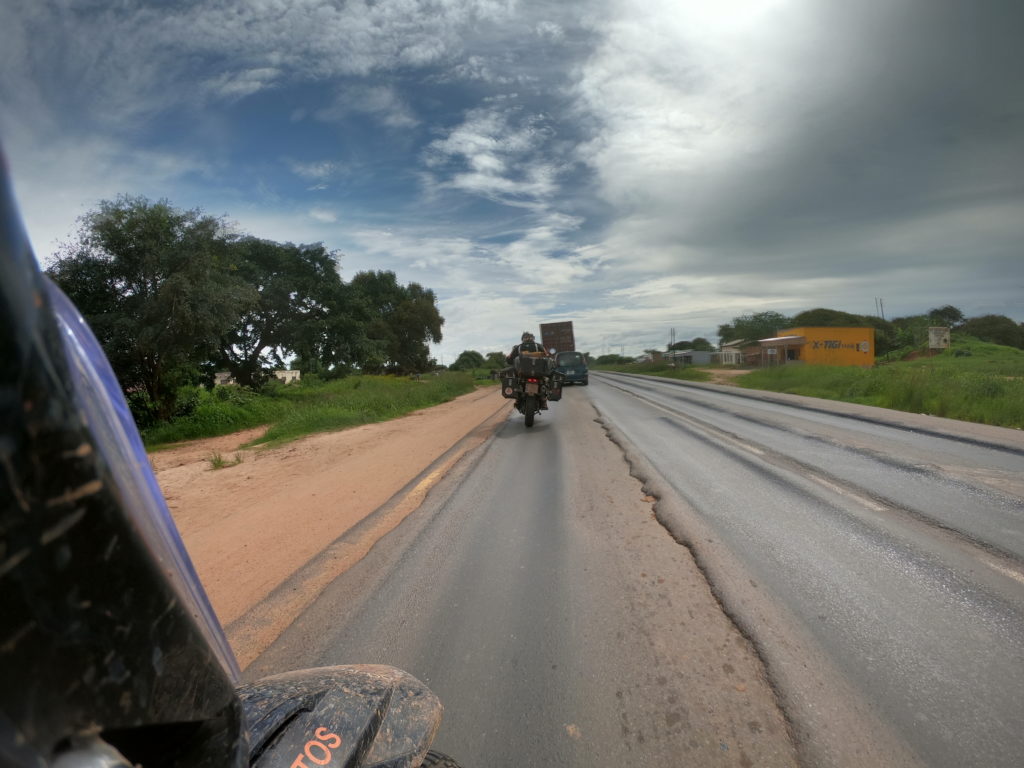
As we have already seen in other countries, China is investing heavily in Africa. Brand new factories stand along the road. Next to them are built housing estates with all the comforts of home. We learn that the Chinese language is taught in Zambian schools. There is no doubt that China is pushing hard to win the African markets.
Near these factories, there is a large mall (shopping centre) with cafes, restaurants, supermarket. As I enter the supermarket I am struck, almost shocked, by the opulence that reigns there. Nothing more than what we find in Europe, but the contrast is once again edifying. We have just spent several days during which we had difficulties to find food so much the mini grocery shops that we visited lack everything.
We stop for the night 50 km from the capital Lusaka, in a farm camping. We meet Pieter who is South African. Pieter is travelling with his wife. They are returning from a holiday in Malawi. Pieter tells us that Cyclone Ana has hit Malawi, he shows us pictures of the water devastating everything. As we don’t follow the news, we didn’t know about this cyclone. Zimbabwe has also been hit hard, 80% of the country is under water, 50% of the population has no electricity. This reminds me of the floods we experienced in Belgium last summer. Early evening the rain reminds us.
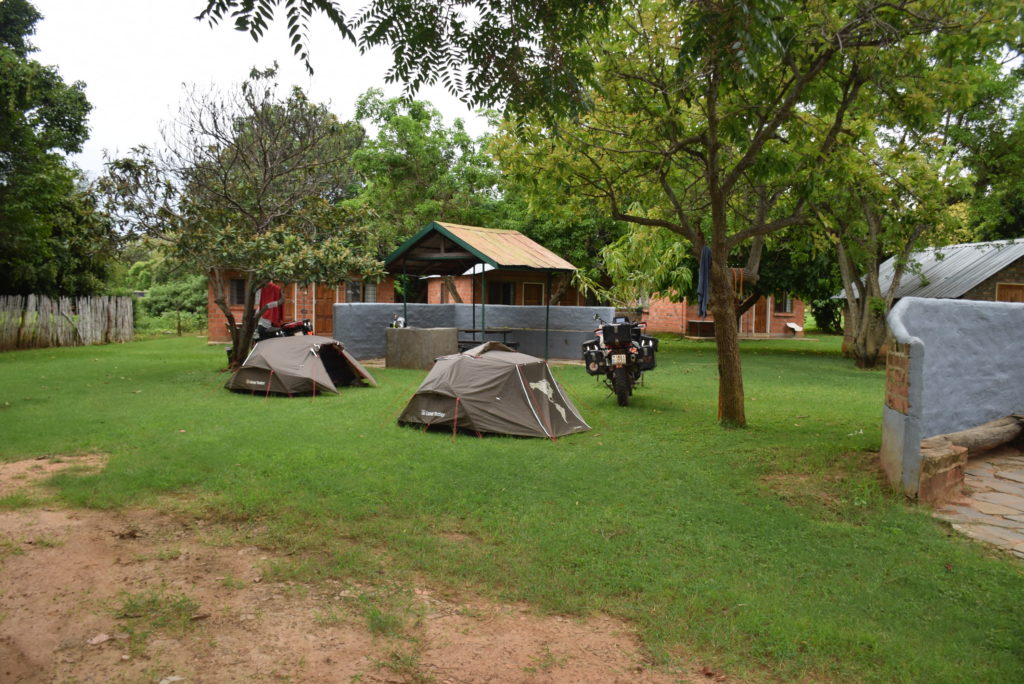
The next morning, it rained all night and it’s still raining. For about two weeks now, I have installed a weather radar app to follow the evolution of the rain. The rain should stop around 12:00. As we plan to stop in nearby Lusaka, we will play our game of tetris when the rain stops.
Around 1pm we leave for Lusaka, we take this famous T4 road in the same conditions as the day before, constant flow of trucks and ruts in the asphalt. We reach Lusaka. Compared to other African cities, the traffic is relatively fluid, but not without danger. We stay in a backpacker hotel, a nice and surprisingly quiet place in the city centre.
Next day
We take advantage of being in a town to do some shopping: screws for my luggage and to properly reattach a deflector on François’ bike; grease for the bikes’ chains; a bank to change money, and a camping mat for François. His died about ten days ago and so far we have only found a fitness mat to replace it. We spend the morning driving around Lusaka. We find a mattress for Francis that is quite bulky but will probably be very comfortable. I just hope I don’t have to shake him like a rock every day at lunchtime. We finally make our way to Lake Kariba.
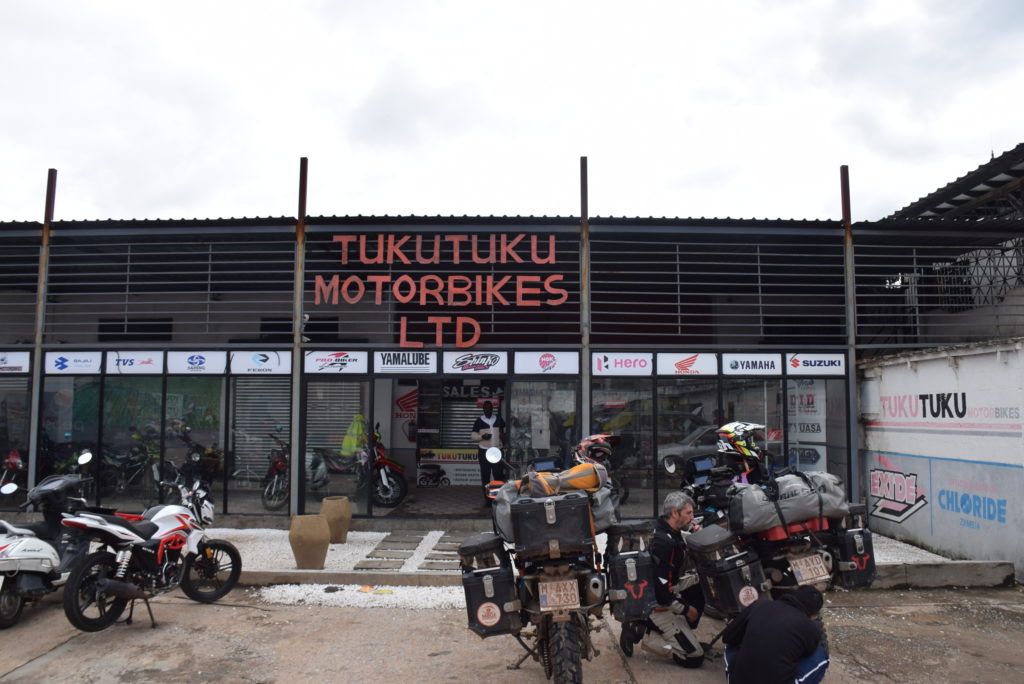
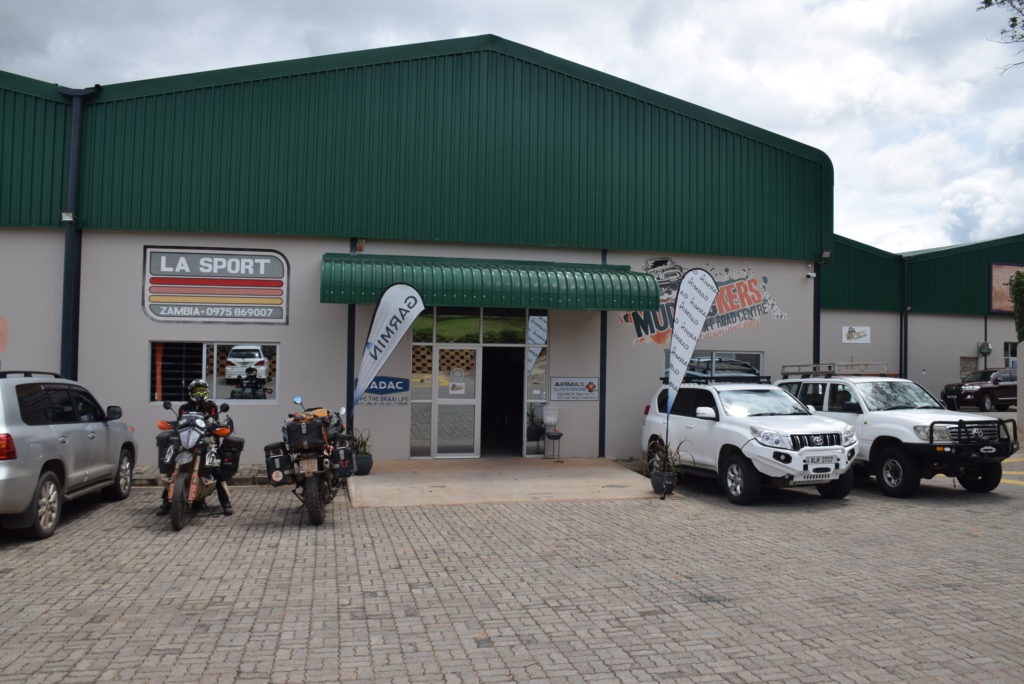
We arrive at the campsite on the edge of the lake, we are welcomed by the owner who explains us at length how the camp works. He greets us and says goodbye, then turns around and comes back to us: “I forgot to tell you, don’t go swimming in the lake there are crocodiles, and at night the hippos come to eat the grass in the campsite. If you get up at night and there are hippos on your way, there is only one thing to do, you turn around and go in the opposite direction, there is no need to shout, or chase them, or throw things at them and everything will be fine. Hmmm, you just have to believe it. Something tells me I’m not going to pee at night while watching the stars.
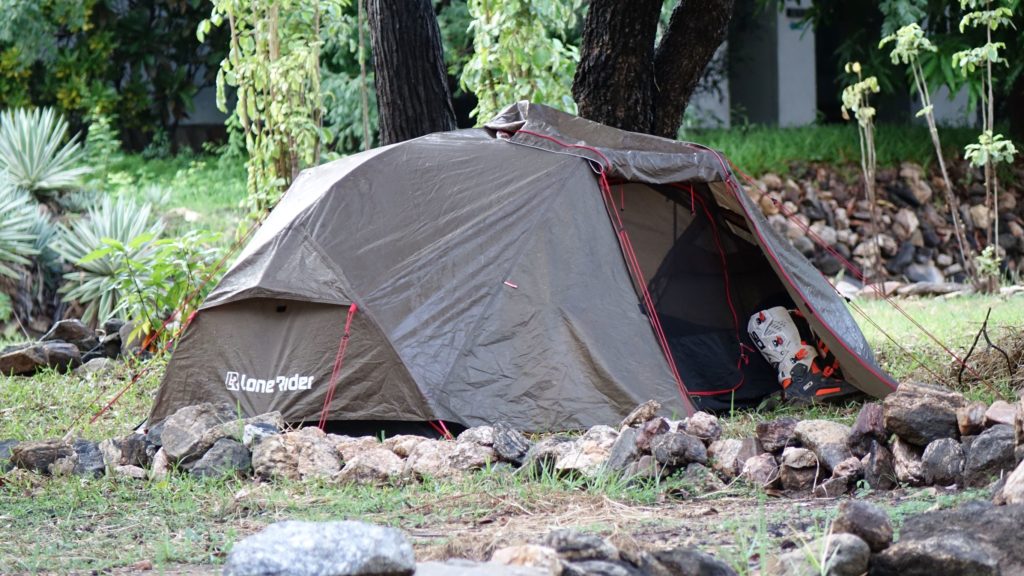
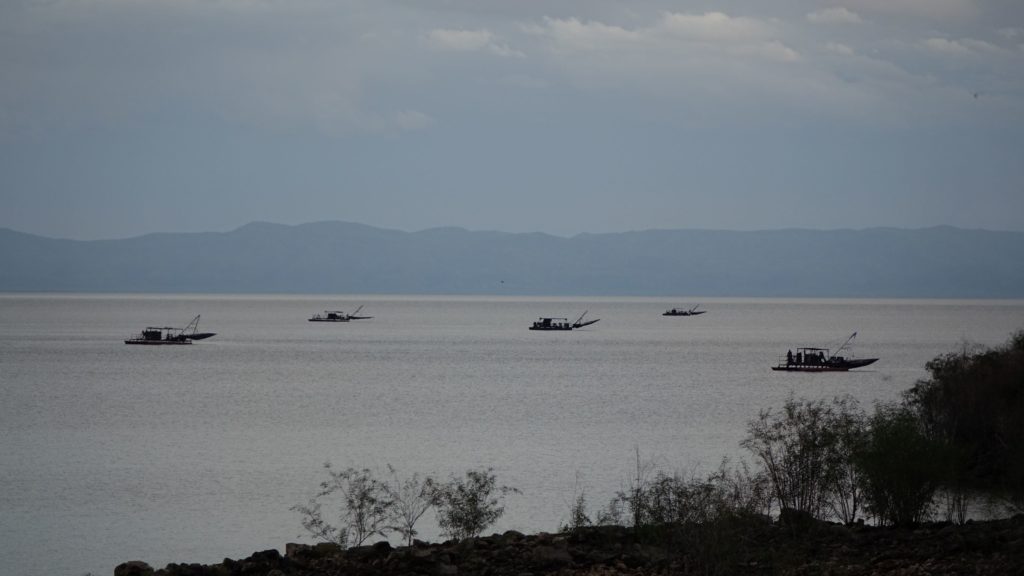
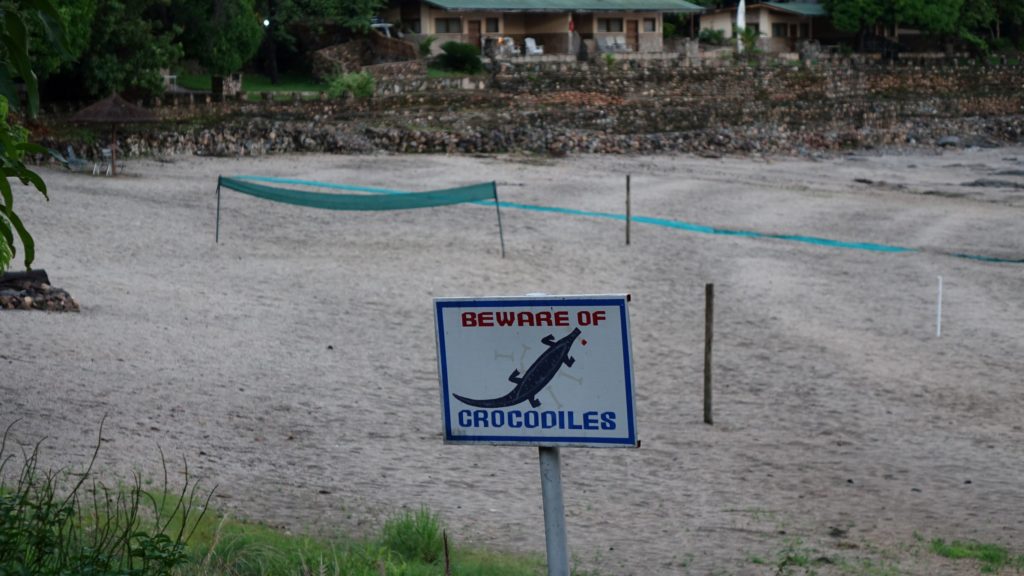
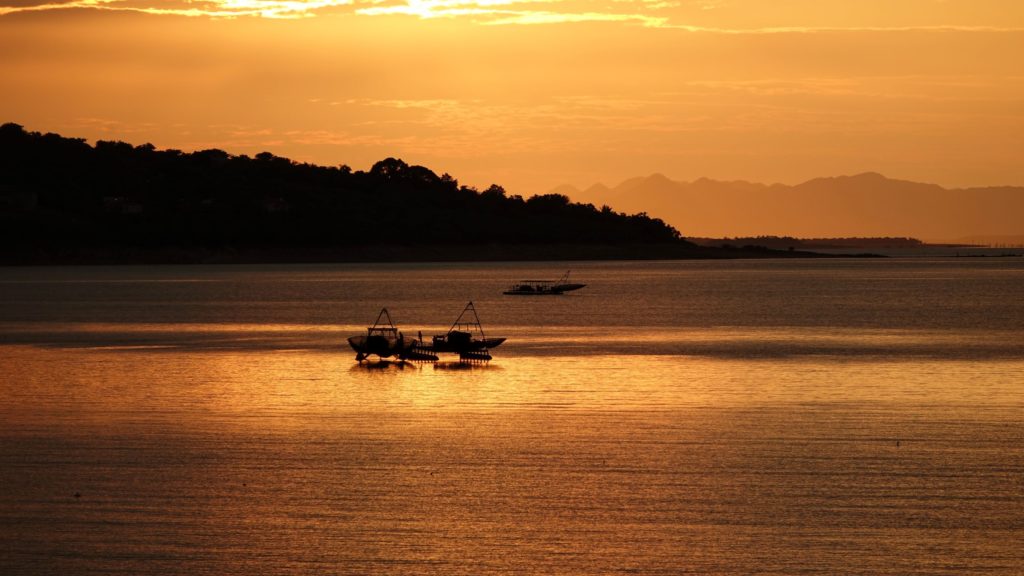
Too Livingstone
On the road to Livingstone, we do not find a campsite. The one we were considering is closed because it was flooded. The owner suggests that we go and pitch our tents at his brother’s place in a farm a few hundred meters away. We will be received by Alex. Alex and two of his brothers run a herd of about 40 dairy cows, a herd of about 40 goats and grow tobacco. Alex is a very nice 19 year old boy who has a good head on his shoulders and knows what he wants. He is waiting for his results to join the Zambian population assistance service. He is interested in developing agriculture. He is both curious and very attentive to us.
Again we have a heavy rainstorm in the evening. It will continue to rain continuously throughout the night.
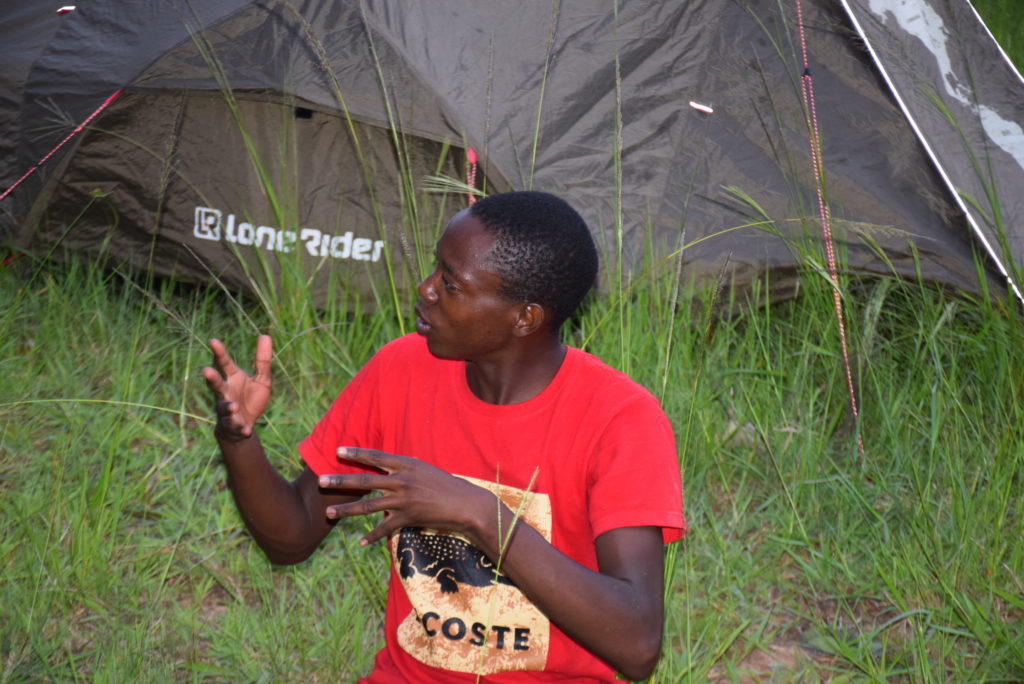
The next morning it rains and rains. I check the weather radar app, there will be no lull until the next day around 6pm. We are cloistered in our tents. We decide to break camp to reach a hotel in Livingstone. Moving out in the rain is a great exercise in organisation. First you have to get everything ready in the tent, then you have to put on your motorbike clothes and rain gear, put on your motorbike boots and helmet and leave the tent equipped like a cosmonaut. Put everything away in the boxes, trying to leave them open as little as possible. Finish by dismantling the tent. After 160 km under the rain we are rinsed. And even if we did our best, there is humidity in the boxes. The hotel is a welcome place to dry our clothes.
The next morning we headed for the Victorian Falls, a 10 minute drive away. The show is as good as we expected
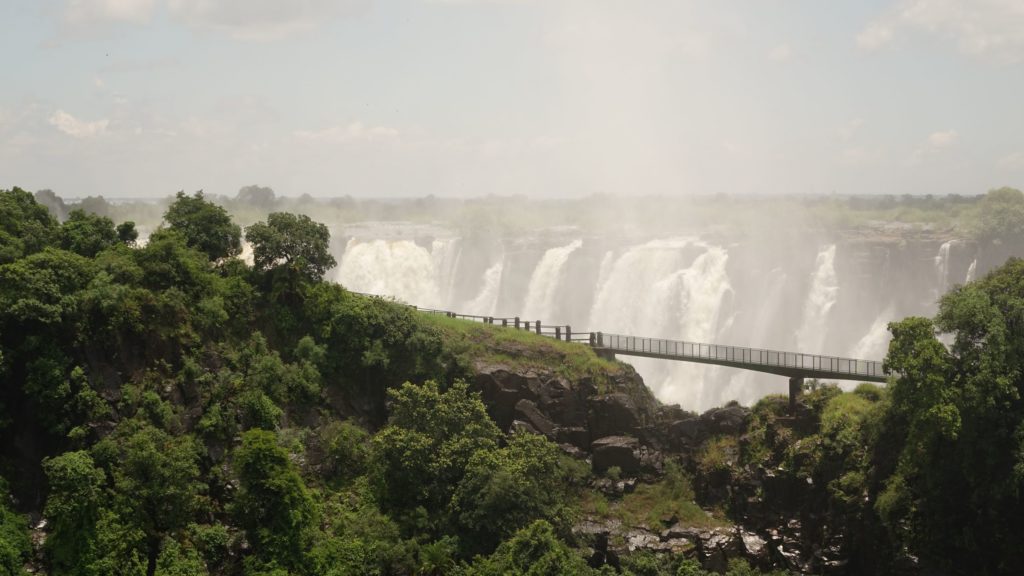
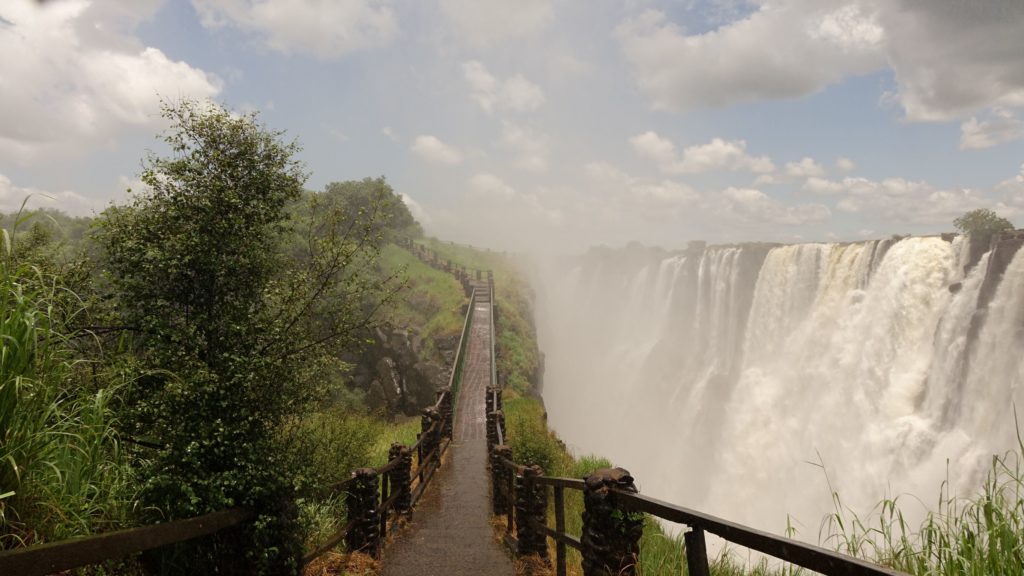
On the way to Botswana
Hi Guys, reading you, one would think that it rains more in Africa than in Belgium 😉
Buy the way, is François still sleeping ? lol
Keep going and enjoy!
Lec